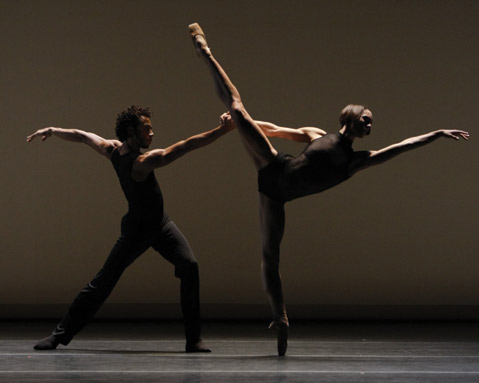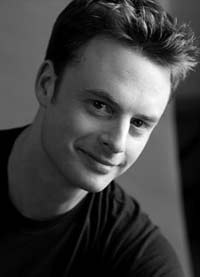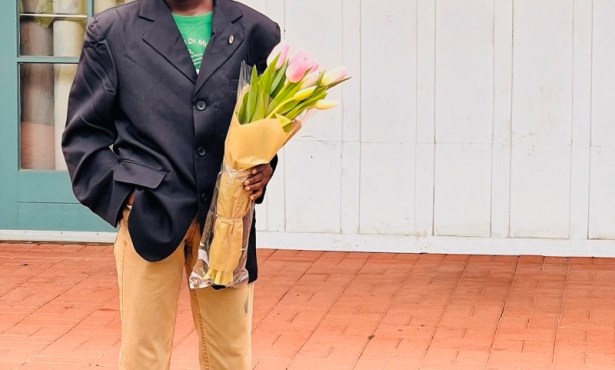Morphoses to Perform at the Granada
Christopher Wheeldon’s New Company to Give its Debut Santa Barbara Performance

At 36 years old, he’s a superstar of the contemporary ballet world, having choreographed 17 works for the New York City Ballet where he was formerly a soloist, and set dances on leading companies from Moscow to London. Now, Christopher Wheeldon is striking out on his own with Morphoses/The Wheeldon Company, the New York and London-based group he founded in 2006 with Cuban-born dancer Lourdes Lopez. His aim is to push ballet into the 21st century, using cross-disciplinary collaborations to fuel artistic innovation, and to keep things fresh. This Friday, January 29, Morphoses makes its debut Santa Barbara appearance at the Granada Theater, where top dancers from NYCB and the UK’s Royal Ballet will perform repertory by Wheeldon alongside works by Paul Lightfoot and Sol Leon of Nederlands Dans Theater, and Alexei Ratmansky of Russia’s Bolshoi Ballet. Last week, I spoke with Wheeldon by phone from his home in New York City.

We’re excited to have Morphoses in Santa Barbara. Will you be joining the company on this leg of the tour?
Yes I will, absolutely. Were excited to be coming too, and we’re just putting the finishing touches on the program.
Have you ever been to Santa Barbara before?
Actually, I’ve only ever driven through Santa Barbara on my way down the Pacific Coast Highway.
I know you like spending time in San Francisco, but it seems like New York is home to you these days.
Yes, it’s where my home is and also my office, and I have lived here 15 years now.
Yet you’re constantly traveling. Has the creation of your own company slowed you down at all, or are you just working harder than ever?
Well at the moment, we’re not a full time company at the moment, so when we are not working I am off setting work on other companies.
Is there an intention for Morphoses to become a full time company?
That has been the goal–to shift to full time eventually–but at the moment with the economy as it is, it’s kind of step by step.
The mission of the company has to do with innovation and collaboration. What does that mean to you?
I think creating a dialogue between artists is very important in any art form. Dance can be inspired by many things. It’s easy to slip into working with designers and composers who have worked with ballet companies before and kind of know the terrain, but I think there’s a much more interesting dialogue that’s created when people come in from outside the dance world and bring a more contemporary perspective to a classical art form.
Can you give some specific examples of collaborations you have found particularly fruitful?
Yes, we’ve worked with a lot of people from the fashion industry: Narcisco Rodriquez, and currently Francisco Costa, who is the creative director for Calvin Klein. He designed the costumes for the Rachmaninoff [Rhapsody Fantaisie] on this program. The lighting design for that piece is by Hugo Dalton, who has never worked in the dance world before. He came with us and spent time with the dancers, watching rehearsal, drawing them.
What does collaborating with designers from the fashion industry look like in terms of your creative process?
It’s interesting. They want to take the conventional ballet costume shape and see it through their eyes. In terms of the use of fabric, they don’t approach the human body in the same way, which can be very refreshing but also can be quite frustrating and difficult for them. Some of the fabrics don’t work for partnering; fabrics used for dance costumes have to be durable, enduring lots of performances, being washed and worn by various dancers…so it’s always a fascinating process, seeing what they come up with.
Tell me a little bit about your two pieces in this program: Continuum, and Rhapsody Fantaisie.
Well, I created Continuum for San Francisco Ballet, so it’s known in that area for the most part. It’s the second of three Ligeti ballets, choreographed to the music of György Sándor Ligeti. It’s very spare and angular, like the music, but I think also captures the dark fantasy of those acerbic pieces of music. I’d say it’s not an instantly accessible ballet for an audience without a lot of experience seeing contemporary ballet. For that reason, before the performance I like to come out on stage and talk through elements of the work, hopefully making the audience’s experience a little more personal. I’ve found that that works nicely, particularly with this work. My experience is that people come away feeling quite enriched by this work, by the music and movement together.
In contrast, the other piece on program, Rhapsody Fantaisie, is lush, romantic, and far more accessible.
In Santa Barbara you’ll be doing a post-show discussion; is that also something you enjoy doing?
Absolutely. I love to field questions—I’m always interested in what people are thinking, and how a piece affects them.
The week before your Santa Barbara appearance, Arts & Lectures will be screening Strictly Bolshoi , the documentary about your experience setting a new ballet on the Bolshoi Ballet in Moscow. How would you sum up that project?
It was really a fantastic experience. In hindsight it was one of those life experiences where everything feels like its crumbling down around you and you are forced to figure out how to rebuild in a different way. I think it was great for the dancers and me to be put in an environment that at first felt very hostile, and then came around. It was a big change for me: a turning point for my confidence as an artist, I think.
It sounds like Michael Nunn and William Trevitt are dancing with you now?
No, they were, not anymore.
The banter between the three of you made the film a lot of fun to watch.
Yes, we’re old school friends. I think that’s what made the film so interesting—we’re very honest with one another. It’s hard to watch, but I think they made a very good film.
Your partner in Morphoses, Lourdes Lopez, is originally from Cuba. Is there a chance of a project in Cuba in the future?
Possibly. We’ve talked about it, but again, at the moment, it’s one step at a time.
You’re setting a piece on the Royal Ballet next year, is that right? Tell me about that project.
It’s a big new piece—it will be the first full-length ballet I’ve done for them. Beyond that I won’t say much; I’ve been sworn to secrecy at the moment.
Since you launched Morphoses a couple of years ago, you’ve received both critical acclaim and harsh criticism. How do you move forward when the feedback is discouraging?
Yeah well, you know, for me every new ballet is like starting over. Working on every new season is like starting with a clean slate. There are disappointments along the way. I guess I have disappointed people with creating the company. I have been outspoken about the art form and what I think we need to do. Whenever you open your mouth and challenge the establishment, you open yourself to criticism. Every tour is new, or else we’re setting the same dance on new dancers, or we’re in new cities…so things are always changing. I think as long as you remain excited about those possibilities, the bare reality of all that negative criticism is bearable. It’s disappointing, but it’s not the end of the world.
What do you do when you need to rejuvenate?
I love my time away from the studio. I do the usual things, I guess: reading a book, relaxing, being at home…I love to just have that home life. I don’t go up to the mountaintops and meditate or anything.
Anything else you’d like your Santa Barbara audience to know?
Just that it’s a terrific group of dancers—world class dancers—coming together for this tour, and that these ballets are abstract but have a very strong emotional context. One of our aims as a company is to make these kind of works accessible and welcoming, so I’d say don’t be afraid to come; don’t be afraid to be open-minded and allow the experience to be personal. That’s what I think people find very challenging about contemporary dance: people think they should know what the choreographer had in mind when he was making the dance and what the story is, but one of the beauties is that it’s open to interpretation. We’re all poetic deep down, and it’s really about letting that instinct out.
4•1•1
Morphoses/The Wheeldon Company will perform at the Granada Theatre on Friday, January 29 at 8pm. For tickets or more information, call 893-3535 or visit artsandlectures.ucsb.edu.



